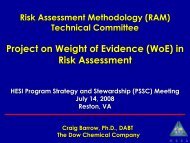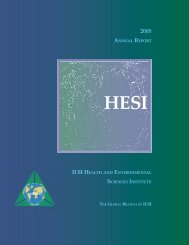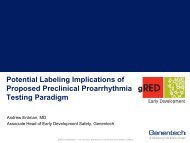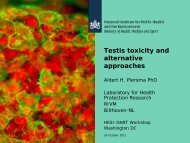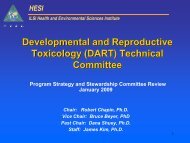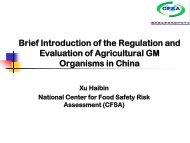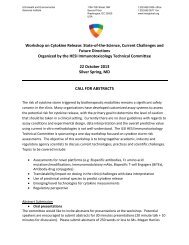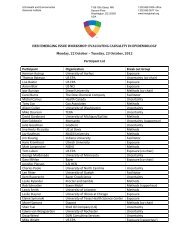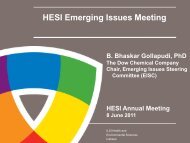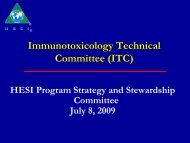Dr. Jason Ward (Monsanto Company, USA) - ILSI Health and ...
Dr. Jason Ward (Monsanto Company, USA) - ILSI Health and ...
Dr. Jason Ward (Monsanto Company, USA) - ILSI Health and ...
Create successful ePaper yourself
Turn your PDF publications into a flip-book with our unique Google optimized e-Paper software.
Biotechnology Protein Safety Assessment:<br />
A GM Case Study<br />
<strong>Jason</strong> <strong>Ward</strong>, PhD<br />
Molecular Characterization<br />
<strong>and</strong> Allergy Lead<br />
<strong>Monsanto</strong> <strong>Company</strong><br />
HESI, PATC<br />
April 16, 2013<br />
<strong>ILSI</strong> <strong>Health</strong> <strong>and</strong><br />
Environmental Sciences<br />
Institute
In 2012 the total area planted globally with biotech<br />
crops increased 6% to 170 million hectares<br />
180<br />
170.3<br />
million hectares<br />
160<br />
140<br />
120<br />
100<br />
Total<br />
Industrial<br />
Developing<br />
88.5<br />
million hectares<br />
80<br />
60<br />
40<br />
81.8<br />
million hectares<br />
20<br />
0<br />
1996 1997 1998 1999 2000 2001 2002 2003 2004 2005 2006 2007 2008 2009 2010 2011 2012<br />
<strong>ILSI</strong> <strong>Health</strong> <strong>and</strong> Environmental<br />
Sciences Institute<br />
Source: James, C., 2012<br />
2
Adoption of GM crops has economic <strong>and</strong><br />
environmental benefits<br />
• Adoption of GM crops has resulted in:<br />
– Reduction in insecticide (213 million kg*) <strong>and</strong><br />
herbicide (230 million kg*) active ingredient use<br />
– Increased use of more environmentally benign<br />
products<br />
– Decreased fuel consumption<br />
– Decreased green house gas emissions<br />
– Changing in farming systems<br />
* Estimated total reduction<br />
from 1996-2010.<br />
Source: Brookes, G <strong>and</strong> Barfoot, P., 2012<br />
<strong>ILSI</strong> <strong>Health</strong> <strong>and</strong> Environmental<br />
Sciences Institute<br />
3
Regulatory Systems have been<br />
established throughout the world<br />
GROWING BIOTECH<br />
GRANTING IMPORT APPROVALS<br />
APPROVING RESEARCH FIELD TRIALS<br />
PROCESS UNDER DEVELOPMENT OR DELAYED<br />
<strong>ILSI</strong> <strong>Health</strong> <strong>and</strong> Environmental<br />
Sciences Institute<br />
Source: James, C., 2012 <strong>and</strong> <strong>Monsanto</strong><br />
4
Overview of the safety assessment of<br />
biotech crops<br />
• The safety assessment includes:<br />
– Detailed characterization of the insertion<br />
– Characterization of the inserted protein<br />
• History of Safe Use<br />
• Allergy Safety Assessment<br />
• Protein Safety Assessment<br />
– Comparison of composition <strong>and</strong> nutritional<br />
components<br />
– Phenotypic <strong>and</strong> ecological assessments<br />
<strong>ILSI</strong> <strong>Health</strong> <strong>and</strong> Environmental<br />
Sciences Institute<br />
5
Roundup Ready® 2 Yield soybeans<br />
• Roundup Ready® 2 Yield soybeans are a second<br />
generation weed control product<br />
– Provide in planta tolerance to Roundup® br<strong>and</strong><br />
agricultural herbicides<br />
• Roundup Ready® 2 Yield soybeans provide<br />
herbicide tolerance by expressing the CP4<br />
EPSPS protein<br />
– CP4 EPSPS is derived from Agrobacterium sp strain<br />
CP4<br />
<strong>ILSI</strong> <strong>Health</strong> <strong>and</strong> Environmental<br />
Sciences Institute<br />
6
History of Safe Use: CP4 EPSPS<br />
• Mode of Action is well understood<br />
– EPSPS enzymes catalyze a key step in the biosynthesis of<br />
aromatic amino acids<br />
– Roundup® br<strong>and</strong> herbicides bind to endogenous EPSPS<br />
proteins which inhibit amino acid production <strong>and</strong> results<br />
in cell death<br />
– CP4 EPSPS protein functions like other endogenous EPSPS<br />
enzymes, however it has a reduced affinity for Roundup®<br />
herbicide binding<br />
• The reduced affinity allows CP4 EPSPS to continue aromatic<br />
amino acid biosynthesis in the presence of Roundup® herbicides<br />
• The ability to continue amino acid biosynthesis confers tolerance<br />
<strong>ILSI</strong> <strong>Health</strong> <strong>and</strong> Environmental<br />
Sciences Institute<br />
7
History of Safe Use: CP4 EPSPS<br />
• CP4 EPSPS is structurally <strong>and</strong> functionally similar to<br />
other EPSPS proteins safely consumed in food <strong>and</strong> feed<br />
– EPSPS enzymes are ubiquitous in plants <strong>and</strong> microorganisms<br />
<strong>and</strong> are safely consumed<br />
– CP4 EPSPS is functionally equivalent to other food derived<br />
EPSPS enzymes except for its tolerance to Roundup®<br />
herbicides<br />
• A number of CP4 EPSPS containing crops have been<br />
commercialized (first in 1996) <strong>and</strong> no adverse effects<br />
have been documented<br />
<strong>ILSI</strong> <strong>Health</strong> <strong>and</strong> Environmental<br />
Sciences Institute<br />
8
Allergy Safety Assessment for Biotech Crops<br />
• Purpose: Determine if the inserted protein is a known<br />
allergen, is cross reactive with a known allergen, or could<br />
become an allergen<br />
– No definitive test of protein allergenicity exists<br />
– ‘Weight of evidence’ approach recommended by Codex<br />
guidelines is used to determine the allergenic potential<br />
of the inserted protein<br />
• Is the protein from an allergenic source<br />
• Is the protein similar to known allergens<br />
• What is the exposure to the protein<br />
<strong>ILSI</strong> <strong>Health</strong> <strong>and</strong> Environmental<br />
Sciences Institute<br />
9
Summary of the Allergy Assessment<br />
• Does the protein originate from an allergenic source<br />
– CP4 EPSPS protein originates from Agrobacterium, which is<br />
not considered an allergenic source<br />
• Does the CP4 EPSPS protein have sequence similarity<br />
to any known allergens<br />
– No similarity with any allergens at the:<br />
• ≥35% identity over 80 or greater amino acids threshold<br />
• E score cut-off of ≤1e-5<br />
• No matching contiguous 8 amino acid segments<br />
– Allergen database (allergenonline.org) has been established<br />
<strong>and</strong> is updated annually <strong>and</strong> curated by international<br />
academic allergy experts<br />
• Bioinformatics assessment is repeated annually<br />
<strong>ILSI</strong> <strong>Health</strong> <strong>and</strong> Environmental<br />
Sciences Institute<br />
10
Summary of the Allergy Assessment<br />
• What is the potential exposure to the inserted<br />
protein<br />
– CP4 EPSPS is expressed in very low levels in the<br />
grain (less than 0.05% of total protein)<br />
– CP4 EPSPS is readily digested in SGF<br />
• >98% of CP4-EPSPS was digested within 15 seconds<br />
• Conclusion: CP4 EPSPS does not pose a<br />
significant allergenic risk.<br />
<strong>ILSI</strong> <strong>Health</strong> <strong>and</strong> Environmental<br />
Sciences Institute<br />
11
Summary of Protein Safety Assessment<br />
• Is the donor organism safe<br />
– Agrobacterium species are not known for human or<br />
animal pathogenicity <strong>and</strong> are not known to be<br />
allergenic<br />
• Does the inserted protein have a history of safe<br />
use<br />
– CP4 EPSPS is structurally <strong>and</strong> functionally similar to<br />
other EPSPS proteins safely consumed in food <strong>and</strong><br />
feed<br />
– CP4 EPSPS containing crops have been<br />
commercialized (first in 1996) <strong>and</strong> no adverse effects<br />
have been documented<br />
<strong>ILSI</strong> <strong>Health</strong> <strong>and</strong> Environmental<br />
Sciences Institute<br />
12
Summary of Protein Safety Assessment<br />
• Does the inserted protein exert toxicity<br />
– Bioinformatics comparison demonstrates that CP4<br />
EPSPS is highly unlikely to share any structural<br />
homology to any known toxins<br />
– As a confirmation CP4 EPSPS was administered as a<br />
single dose by gavage to mice at 572 mg/kg <strong>and</strong> had no<br />
adverse effects<br />
• Conclusion: No evidence that CP4 EPSPS is likely<br />
to pose a safety risk.<br />
<strong>ILSI</strong> <strong>Health</strong> <strong>and</strong> Environmental<br />
Sciences Institute<br />
13
Summary of the Characterization of CP4 EPSPS<br />
• CP4 EPSPS has a well characterized mode of action<br />
• CP4 EPSPS has a long history of safe use<br />
– CP4 EPSPS is structurally <strong>and</strong> functionally similar to other<br />
EPSPS proteins safely consumed in food <strong>and</strong> feed<br />
– CP4 EPSPS containing crops have been commercialized (first<br />
in 1996) <strong>and</strong> no adverse effects have been documented<br />
• CP4 EPSPS has no sequence similarity to known<br />
allergens<br />
• CP4 EPSPS is readily digested in SGF<br />
• CP4 EPSPS does not exert toxicity<br />
• Conclusion: There is no evidence that CP4 EPSPS is<br />
likely to pose a safety or allergenic risk.<br />
<strong>ILSI</strong> <strong>Health</strong> <strong>and</strong> Environmental<br />
Sciences Institute<br />
14
References Cited in this Presentation<br />
• Brookes, G <strong>and</strong> Barfoot, P. (2012). Global Impact of Biotech Crops,<br />
Environmental effects, 1996-2010. GM Crops <strong>and</strong> Food:<br />
Biotechnology in Agriculture <strong>and</strong> the Food Chain 3:2, 129-137.<br />
• James, C. (2012). ISAAA Brief 44, Global Status of Commercialized<br />
Biotech/GM Crops: 2012.<br />
<strong>ILSI</strong> <strong>Health</strong> <strong>and</strong> Environmental<br />
Sciences Institute<br />
15
THANK YOU<br />
<strong>Monsanto</strong> <strong>Company</strong><br />
Confidential<br />
<strong>ILSI</strong> <strong>Health</strong> <strong>and</strong> Environmental<br />
Sciences Institute<br />
16



